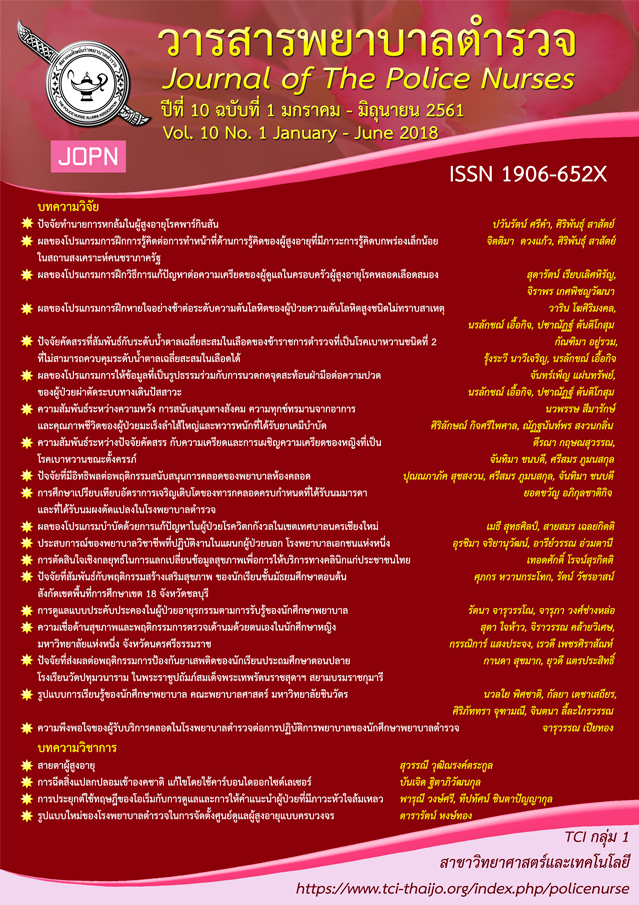ปัจจัยทำนายการหกล้มในผู้สูงอายุโรคพาร์กินสัน
คำสำคัญ:
การหกล้ม, ผู้สูงอายุ, โรคพาร์กินสัน, การหกล้ม, ผู้สูงอายุ, โรคพาร์กินสันบทคัดย่อ
การวิจัยครั้งนี้มีวัตถุประสงค์เพื่อศึกษา 1) การหกล้มของผู้สูงอายุโรคพาร์กินสันที่เข้ารับการรักษาในคลินิกโรคพาร์กินสัน แผนกอายุรกรรมประสาทของโรงพยาบาลรัฐบาลในระดับตติยภูมิ เขตกรุงเทพมหานคร 2) ความสัมพันธ์ระหว่างปัจจัยคัดสรร ได้แก่ การสูญเสียการทรงตัว ภาวะซึมเศร้า ความกลัวการหกล้ม สิ่งแวดล้อมภายในบ้าน แรงสนับสนุนทางสังคมจากครอบครัว กับการหกล้มในผู้สูงอายุโรคพาร์กินสัน และ 3) ปัจจัยทำนายการหกล้มในผู้สูงอายุโรคพาร์กินสัน ตัวอย่างเป็นผู้สูงอายุโรคพาร์กินสันที่ได้รับการคัดเลือกแบบบังเอิญ จำนวน 152 ราย เครื่องมือที่ใช้ในงานวิจัยคือ แบบประเมินภาวะซึมเศร้า แบบประเมินความกลัวการหกล้ม และแบบประเมินปัจจัยสิ่งแวดล้อมภายในบ้าน วิเคราะห์ข้อมูลโดยใช้สถิติเชิงบรรยาย, Point Biserial Correlation, และ Binary Logistic Regression Analysis
ผลการวิจัยพบว่า ตัวแปรที่สามารถร่วมกันทำนายโอกาสเกิดการหกล้มในผู้สูงอายุโรคพาร์กินสันได้อย่างมีนัยสำคัญทางสถิติที่ระดับ.05 คือ การสูญเสียการทรงตัว ความกลัวการหกล้ม สิ่งแวดล้อมภายในบ้าน และแรงสนับสนุนทางสังคมจากครอบครัว โดยสามารถทำนายโอกาสเกิดการหกล้มในผู้สูงอายุโรคพาร์กินสันได้ ร้อยละ 56.70 ซึ่งผลการวิจัยนี้มีประโยชน์ในการนำไปใช้ในการดูแลผู้สูงอายุโรคพาร์กินสัน ตลอดจนเป็นแหล่งข้อมูลปัจจัยที่เกี่ยวข้องกับการหกล้มในผู้สูงอายุโรคพาร์กินสันสำหรับนักศึกษาพยาบาลและผู้ที่สนใจได้เป็นอย่างดี
Downloads
เอกสารอ้างอิง
Beck, A. T., Rush, A. J., Shaw, B. F., & Emery, G. (1979). Cognitive therapy of depression. New York: Guilford.
Bhidayasiri, R., Wannachai, N., Limpabandhu, S., Choeytim, S., Suchonwanich, Y., & Tananyakul, S., (2011). A national registry to determine the distribution and prevalence of Parkinson’s disease in Thailand: Implications of urbanization and pesticides as risk factors for Parkinson’s disease. Journal of Neurology, 37(3-4), 222-230.
Bloem, B. R., Bleckley, D. J., Hillten, B. R., & Roos, R. A. (2001). Clinicmetrics of postural instability in Pakinson’s disease. The Journal of Neurological, 73(5), 245-258.
Bloem, B. R., Hausdoff, J. M., Visser, J.E., & Giladi, N. (2007). Fall and freezing of gait in Pakinson’s disease: A review of two interconnected, episodic phenomena. Movement Disorders, 19(1), 871-874.
Boonchome, R. (1994). Comparative study of families roles in prevention of home accidents for the aged receiving the services from the government and private hospital : A case study of Parkkred hospital and Parkkred Vejchakarn general hospital (Master. Science, Social Work). Thammasat University, Bangkok.
Brotherton, S., Krause, J., Nietert, P. (2007). Fall in individuals with incomplete spinal cord injury. Spinal Cord. 45(37-40), 100-110.
Burns N, & Grove, S, K. (2005). The practice of nursing research: Conduct critique and utilization (5th ed.) St. Louis, Elsevier Saunders
Calne, M. S., (2005). Late-stage Parkinson’s disease for the rehabilitation specialist: Anursing perspective. Topics in Geriatric Rehabitation, 21(3), 233-246.
Caplan, G. (1974). Support Systems and community mental health: Lectures on concept development. New York: Behavioral Publications.
Ditruchgij, C. (2009). Experiences of living with Parkinson disease of Thai elderly (Master Degree of Nursing Science, Gerontology Nursing). Faculty of Nursing, Chulalongkorn University, Bangkok.
Hale, W. A., Declancy, M. J., & McGaghie, W. C. (1992). Charecteristics and predictors of fall in elderly patient. The Journal of Neurological, 60(4), 150-161.
Huse, D. M., Schulman, K., Orsini, L., Castelli-Haley, J., Kennedy, S., & Lenhart, G. (2006). Burden of illness in Parkinson's disease. Movement Disorder, 20(11), 1449-1454.
Institute of Geriatric medicine. (1999). Mini-mental state examination–Thai version 2002 (MMSE-Thai
2002). Bangkok: Ministry of Public Health.
Kamata, N., Matsuo, Y., Yoneda, T., Shinohara, H., Inoue, S., Abe, K. (2007). Overestimation of stability limits lead to a high frequency of fall in patients with Parkinson’s disease. Clinical Rehabitation, 21(4), 357-361.
McDonald, W. M., Richard, I. H., & DeLong, M. R. (2003). Prevalence, etiology, and treatment of depression in Parkinson's disease. PubMed, 54(3), 363-375.
Mak, M. K. Y., & Pang, M. Y. C. (2010). Parkinsonian single fallers versus recurrent fallers: Different fall characteristics and clinical features. Journal of Neurology, 257(9), 1543-1551.
Miller, N., Noble, E., Jones, D., & Burn, D. (2006). Life with communication change in Parkinson’s disease. Age and Ageing, 35(3), 235-239.
Pangjai, R. (1999). Spousal support and well-being of the elderly (Master of Nursing Science Program in Geriatric). Chiang Mai University, Chiang Mai.
Panjamanas, R. (2005). Fall assessment and social support from family among elderly people in community (Master Nursing Science, Community Health Nursing). Mahidol University, Bangkok.
Podsiadlo, D., & Richardson, S. (1991). The timed “up and go”: A test of basic functional mobility for frail elderly persons. Journal of American Gerontology Society, 39, 142-148.
Poungvarin, N. (2005). Pakinson’s disease. Bangkok: Reunkaew printing.
Rudzinska, M., Bukowczan, S., Stozek, J., Zajdel, K., & Mirek, E. (2013). Causes and consequences of fall in Parkinson disease patient in a prospective study. Neurologial Neuroochirurgia Polska, 47(5), 423-430.
Sriyong, M. (1979). Depression of suicidal attempted persons at Fang hospital (Master of Nursing Science Program in Psychiatric and Mental Health). Chiang Mai University). Chiang Mai province.
Stein, M. B., Heuser, I. J., & Juncos, J. L. (1990). Anxiety disorders in patients with Parkinson's disease. Journal of Psychiatry, 147, 217-220.
Thaweewannakij, T. H., Amatachaya, S., Peungsuwan, P. & Mato, L. (2010). Fall and quality of life in active
and inactive elderly. Journal of the Medical Association of Thailand, 22(3), 271-279.
Thiamwong, L., & Petsirasan. R. (2009). Intrinsic risk factors of falls among Thai older adults in the
long-term institutional care. Thai Journal of Nursing Council, 24(1), 77-87.
Tinetti, M. E., Richman, D., & Powell, L. (1990). Falls efficacy as a measure of fear of falling. Journal of Gerontology, 45(6), 239-243.
Voss, T. S., Ele, J. J., Wielinski, C. L., Aminoff, M. J., Bandyyopadhyay, D., Chou, K. L., …, Falls Writing Group NINDS NET-PD Investigators. (2012). Fall frequency and risk assessment in early Pakinson’s disease. Parkinsonism and Related Disorders, 18(7), 837-841.
Wood, B. H., Bilclough, J. A., Bowron, A., & Walker, R. W. (2002). Incidence and prediction of fall in
Parkinson’s disease: A prospective multidisciplinary study. Journal of Neurological Neurosurgical Psychiatry, 72(6), 721-725.
World Health Organization. (2007). WHO global report on falls prevention in older age. France.
ดาวน์โหลด
เผยแพร่แล้ว
รูปแบบการอ้างอิง
ฉบับ
ประเภทบทความ
สัญญาอนุญาต
ผลงานที่ได้ตีพิมพ์แล้วจะเป็นลิขสิทธิ์ของวารสารพยาบาลตำรวจ















